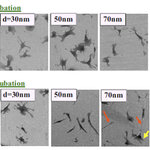Microbiology

We learn a lot from genes but it turns out we can learn even more - like where you lived or even who you spent time with. It just requires knowing where and how to look.
Researchers from Stanford and Tel-Aviv University are using a technique called "reverse ecology" to examine metabolic networks and pull out proxies for reconstructing bacterial environments millions of years in the past. The work, published in the February issue of the Journal of Computational Biology, offers clues to the complex evolutionary interplay between organisms such as parasites and hosts.
Researchers have…

As we mark the 200th anniversary of Charles Darwin's birth, there is much focus on evolution in animals and plants. But new research shows that for the countless billions of tiniest creatures – microbes – large-scale evolution was completed 2.5 billion years ago.
All living organisms need nitrogen, a basic component of amino acids and proteins. But for atmospheric nitrogen to be usable, it must be "fixed," or converted to a biologically useful form. Some microbes turn atmospheric nitrogen into ammonia, a form in which the nitrogen can be easily absorbed by other organisms.
But the new…

A little more than a year after University of Wisconsin-Madison scientists showed they could turn skin cells back into stem cells, they have pulsating proof that these "induced" stem cells can indeed form the specialized cells that make up heart muscle.
In a study published in Circulation Research, the team showed that they were able to grow working heart-muscle cells (cardiomyocytes) from induced pluripotent stem cells, known as iPS cells.
The heart cells were originally reprogrammed from human skin cells by James Thomson and Junying Yu, two of Kamp's co-authors on the…

A multi-institutional team of researchers has reported the sequences for all of the 99 known strains of cold virus, nature's most ubiquitous human pathogen. The feat exposes, in precise detail, all of the molecular features of the many variations of the virus responsible for the common cold, the inescapable ailment that makes us all sneeze, cough and sniffle with regularity.
Conducted by teams at the University of Maryland School of Medicine, the University of Wisconsin-Madison and the J. Craig Venter Institute, the work to sequence and analyze the cold virus genomes lays a foundation…

Many of the world's cultural treasures are creations made of organic materials such as paper, canvas, wood and leather which, in prolonged warmth and dampness, attract mold, micro-organisms and insects, causing decay and disintegration.
New biotechnology techniques described at a 4-day, UN-affiliated international conference in Caracas include the use of micro-organisms to remove fungus and other problems on artwork, photos, documents, masonry and more.
Says Jose-Luis Ramirez, Director of the United Nations University's Programme for Biotechnology for Latin America and the Caribbean (…

The simple recipe scientists earlier discovered for making adult stem cells behave like embryonic-like stem cells just got even simpler. A new report in the February 6th issue of the journal Cell shows for the first time that neural stem cells taken from adult mice can take on the characteristics of embryonic stem cells with the addition of a single transcription factor. Transcription factors are genes that control the activity of other genes.
The discovery follows a 2006 report also in the journal Cell that showed that the introduction of four ingredients could transform differentiated…

Monash Institute of Medical Research (MIMR) scientists have created Australia's first induced pluripotent stem (iPS) cell lines. They have derived the cells from skin cells, and reprogrammed them to behave as embryonic stem cells; a breakthrough that will allow Australian scientists unlimited access to study a range of diseases.
Until now, Australian scientists have had to import human iPS cells from America or Japan.
Program leader, Dr Paul Verma, said the significance of developing iPS cells 'in-house' cannot be underestimated. "We now have the capability to investigate any human…

Nanotubes are often regarded as a precursor to nanocircuitry. A group at UC San Diego has found that they work pretty well for transferring biological information, too. Oh, et al. showed that selective differentiation of stem cells into bone cells could be achieved on titanium nanowires of approximately 70-100 nanometers in diameter. Using smaller nanowires caused less selectivity and slower differentiation. This suggests that the shape of the nanowires provided a signal to metamorphose into bone cells.
The cells generated on the nanowires are osteoclasts, the bone-building…

Researchers from Northwestern University's Feinberg School of Medicine appear to have reversed the neurological dysfunction of early-stage multiple sclerosis patients by transplanting their own immune stem cells into their bodies and thereby "resetting" their immune systems.
The patients in the small phase I/II trial continued to improve for up to 24 months after the transplantation procedure and then stabilized. They experienced improvements in areas in which they had been affected by multiple sclerosis including walking, ataxia, limb strength, vision and incontinence. The study will…

This is so cool (and the original source is here, but you have to scroll down a while to get to it). Just don't let it get out to those crazy people who think that scientists don't do anything worthwhile.